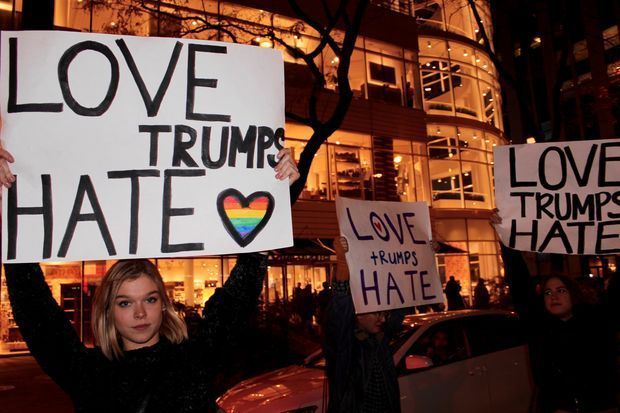
01 January 2017
TRENDING
The night he won the presidency, Donald Trump gave a speech that was praised for its magnanimity.
"Now it's time for America to bind the wounds of division; have to get together," he said, reading his prepared remarks from the teleprompter.
To all Republicans and Democrats and independents across this nation, I say it is time for us to come together as one united people. It's time. I pledge to every citizen of our land that I will be president for all Americans, and this is so important to me. For those who have chosen not to support me in the past, of which there were a few people, I'm reaching out to you for your guidance and your help so that we can work together and unify our great country.
Those who opposed Trump didn't immediately embrace him. For several nights after he won, protesters marched in opposition to his victory — crowds that had large contingents of young people, women and people of color.
After the two met in the Oval Office, President Obama recommended that Trump's attempts to unify the country focus on those groups.
"I did say to him, as I've said publicly, that because of the nature of the campaigns and the bitterness and the ferocity of the campaigns, it's really important to send some signals of unity," Obama said to reporters following that meeting, "and to reach out to minority groups, or women, or others that were concerned about the tenor of the campaign, and I think that's something that he will want to do."
Trump chose not to do so. He dismissed the protesters as "professionals" who were "incited by the media," calling the protests unfair. He named Stephen K. Bannon, the controversial head of Breitbart News, as a senior adviser who would staff him in the White House. He seemed, in short, to define "unity" as America embracing him — and not his reaching out to meet those Americans who opposed him halfway.
This came into focus on Saturday, the final day of 2016, thanks to another tweet from the president-elect.
Before Thanksgiving, Trump released a video message offering his thoughts to the country."It is my prayer that on this Thanksgiving we begin to heal our divisions and move forward as one country, strengthened by a shared purpose and very, very common resolve," he said.
He continued:
We have just finished a long and bruising political campaign. Emotions are raw and tensions just don't heal overnight. It doesn't go quickly, unfortunately, but we have before us the chance now to make history together to bring real change to Washington, real safety to our cities and real prosperity to our communities, including our inner cities. So important to me, and so important to our country. But to succeed, we must enlist the effort of our entire nation. ... I am asking you to join me in this effort. It is time to restore the bonds of trust between citizens. Because when America is unified, there is nothing beyond our reach, and I mean absolutely nothing.
Less than two weeks later, he made his first "thank you tour" stop in Ohio. Our report on the event summarized the topics covered: the dishonest press, his frustration with Republican Gov. John Kasich (who didn't support him) and how protesters at the event "don't know that Hillary lost a couple of weeks ago."
Despite that, he insisted that "we are going to bring our country together — all of our country. We're going to find common ground, and we will get the job done properly." As the crowd chanted "lock her up," he said, "we did have a lot of fun fighting Hillary didn't we?"Part of Trump's frustration over his political opponents stems from the fact that he only narrowly won, earning more electoral college votes despite losing the popular vote by almost 3 million votes. (He has tried to dismiss this as being the result of votes cast illegally, which is patently untrue.) He has also more recently been annoyed at suggestions that Russia's apparent hack of the Democratic National Committee may have pushed him over the finish line. In response, Trump has said that Russia's efforts are old news that everyone should move past.
Past presidents have similarly entered office to lead a divided nation. For Trump, the path to unity is narrow: Stop complaining about him and unify around him. When given a teleprompter, Trump makes the sort of pronouncements about working together that you'd expect of a president-elect. Once he grabs his phone and starts tweeting, though, his real thoughts — as always — leak out.
This is reprinted from the Washington Post, on December 31, 2016. The writer is Philip Bump who writes about politics for The Fix. He is based in New York City.
###
January 1, 2016
Addendum. Voices4Hillary found his remarks to unite the nation on the night of November 8 perfunctory at best. We believe that some people were so eager to have America heal that they attributed an effort that wasn't there